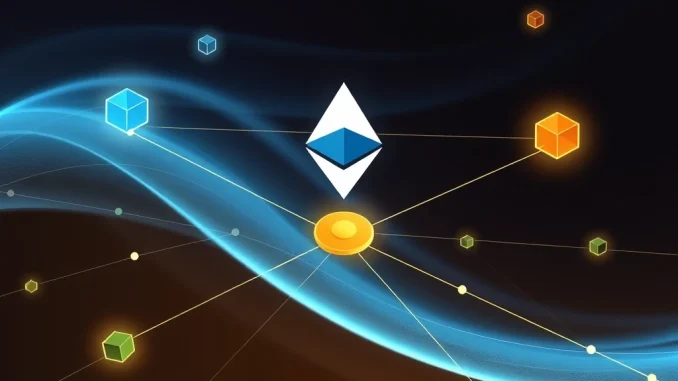
The world of decentralized finance (DeFi) is constantly evolving, pushing the boundaries of what’s possible on the blockchain. A key challenge in this ecosystem has always been the lack of seamless communication and interaction between different blockchain networks. This is where the concept of cross-chain staking and interoperability becomes crucial.
Addressing this critical need, Symbiotic, a notable restaking protocol, has unveiled its latest innovation: the Relay Software Development Kit (SDK). This launch represents a significant step towards simplifying the creation of secure, multichain applications by leveraging the robust security of Ethereum staking.
What is Symbiotic Restaking and Why Does Relay Matter?
Symbiotic operates as a restaking protocol, allowing users to repurpose their staked ETH or Liquid Staking Tokens (LSTs) to secure various decentralized services beyond the Ethereum network itself. This mechanism increases the capital efficiency for stakers and provides decentralized services with access to a large pool of cryptoeconomic security derived from Ethereum’s proof-of-stake consensus.
The challenge arises when these decentralized services need to operate or verify activity across multiple different blockchains. Traditionally, building secure cross-chain infrastructure like bridges or oracles required establishing entirely new validator sets or relying on complex, often less secure, multi-signature schemes.
Relay changes this paradigm. It’s designed as an SDK that allows developers building on Symbiotic to easily enable Ethereum-based staking to verify events and states on other blockchains. Think of it as a standardized toolkit that abstracts away much of the complexity involved in creating secure connections between chains.
Here’s a breakdown of what Relay does:
- Enables Verification: Allows Symbiotic’s restaked validators (secured by Ethereum) to cryptographically verify activities occurring on non-Ethereum chains.
- Simplifies Development: Provides pre-built components and frameworks for developers to integrate cross-chain verification into their applications.
- Leverages Existing Security: Harnesses the economic security already present in Ethereum staking, rather than requiring the bootstrap of new trust networks.
Boosting Blockchain Interoperability with Relay
True blockchain interoperability is the holy grail for a connected Web3 ecosystem. It envisions a future where assets and data can move freely and securely between different networks, unlocking new possibilities for users and developers alike.
While bridges exist, they have historically been points of vulnerability, often targeted by malicious actors. Oracles, which feed external data into smart contracts, also require robust security mechanisms, especially when sourcing data from or about other chains.
Relay directly addresses these security and complexity issues for a specific class of interoperability solutions. By allowing services secured by Symbiotic to verify cross-chain information directly using the collective security of Ethereum stakers, it provides a potentially more secure and capital-efficient method for building these vital pieces of infrastructure.
Consider the impact on:
- Secure Bridges: A bridge could use Symbiotic validators, verified via Relay, to confirm events on a source chain before releasing assets on a destination chain.
- Reliable Oracles: Oracles could use Relay to fetch and verify data feeds from other chains or even real-world events attested to by validators operating cross-chain.
- Multichain Protocols: DeFi protocols or dApps wanting to operate across multiple chains can use Relay to build components that require verifying states or actions happening elsewhere.
Building the Future: Multichain Applications Made Easier
The launch of Relay is particularly exciting for developers looking to build the next generation of multichain applications. The SDK aims to lower the barrier to entry for creating secure cross-chain functionalities.
Instead of spending significant resources on setting up and securing a new validator set for each specific cross-chain service, developers can potentially tap into Symbiotic’s existing network of restaked security providers and use the Relay SDK to integrate the necessary verification logic.
This focus on developer experience and simplification is crucial for fostering innovation. Easier tools lead to more experimentation and ultimately, more useful and secure applications for end-users across the decentralized landscape.
The timing of this launch is also noteworthy, following Symbiotic’s successful closure of a $29 million Series A funding round led by Pantera Capital. This significant capital infusion suggests strong investor confidence in Symbiotic’s vision for restaking and its potential to underpin crucial decentralized infrastructure.
What Does This Mean for Developers and Users?
For developers, Relay offers a powerful new tool to build more ambitious and secure applications that aren’t confined to a single blockchain. It could significantly reduce the complexity and cost associated with creating cross-chain services.
For users, the long-term impact could be a more interconnected and secure DeFi ecosystem. Imagine safer bridges, more reliable oracles, and applications that seamlessly interact with assets and data across different networks without requiring users to navigate complex, risky processes.
While Relay is an SDK primarily for builders, its success will ultimately benefit anyone participating in or using decentralized applications that require cross-chain interaction.
Conclusion: A Step Towards a More Connected Web3
Symbiotic’s launch of the Relay SDK is a compelling development in the restaking space and a notable contribution to the ongoing effort to achieve robust blockchain interoperability. By providing developers with a streamlined way to leverage Ethereum’s security for verifying cross-chain activity, Relay has the potential to accelerate the development of more secure and efficient multichain applications.
This move underscores the growing importance of restaking protocols like Symbiotic in providing decentralized security infrastructure for the wider Web3 ecosystem. As the demand for seamless cross-chain staking and interaction grows, tools like Relay will be instrumental in building the connected future of decentralized finance.



